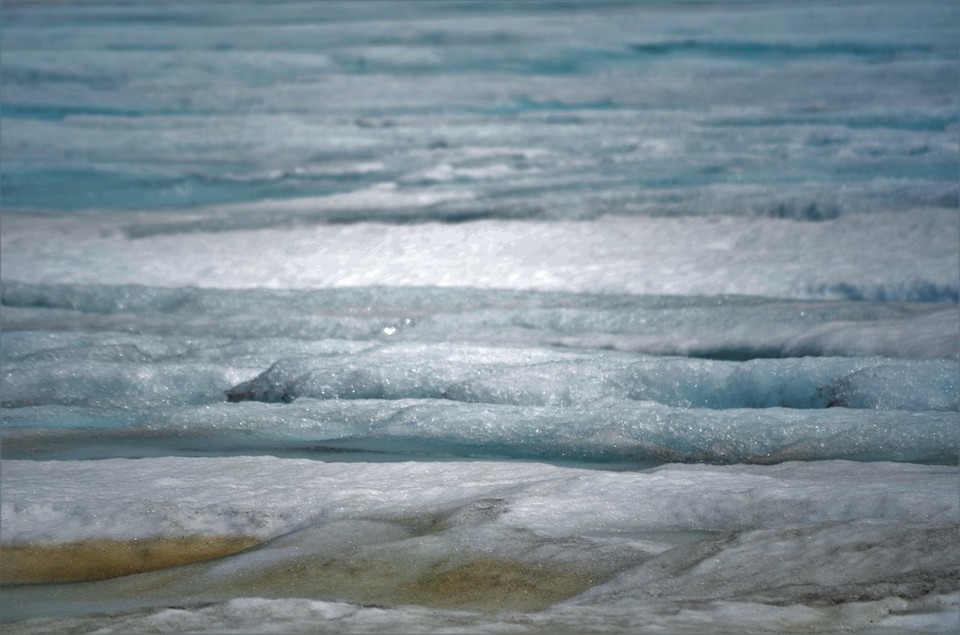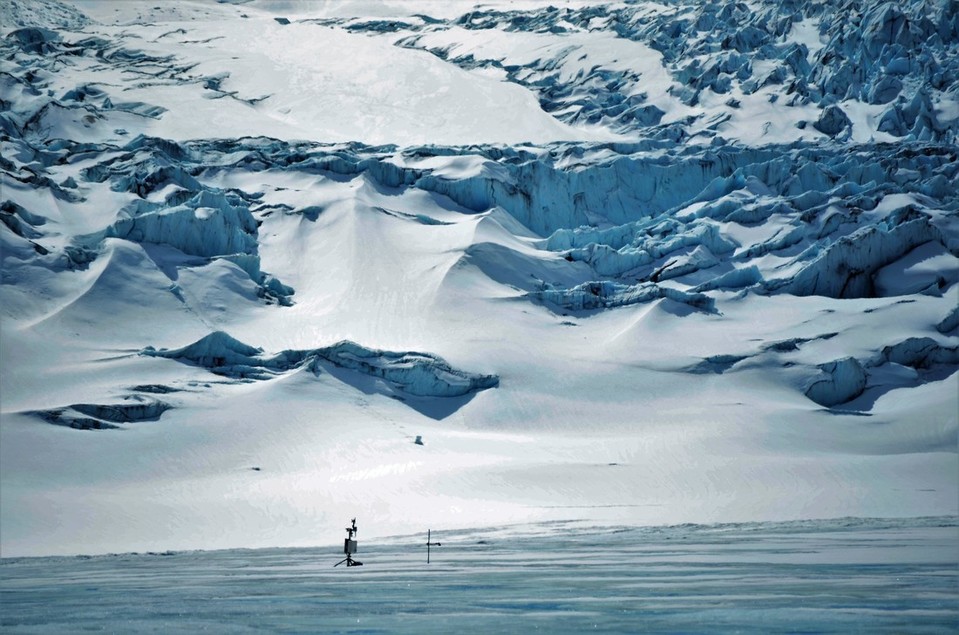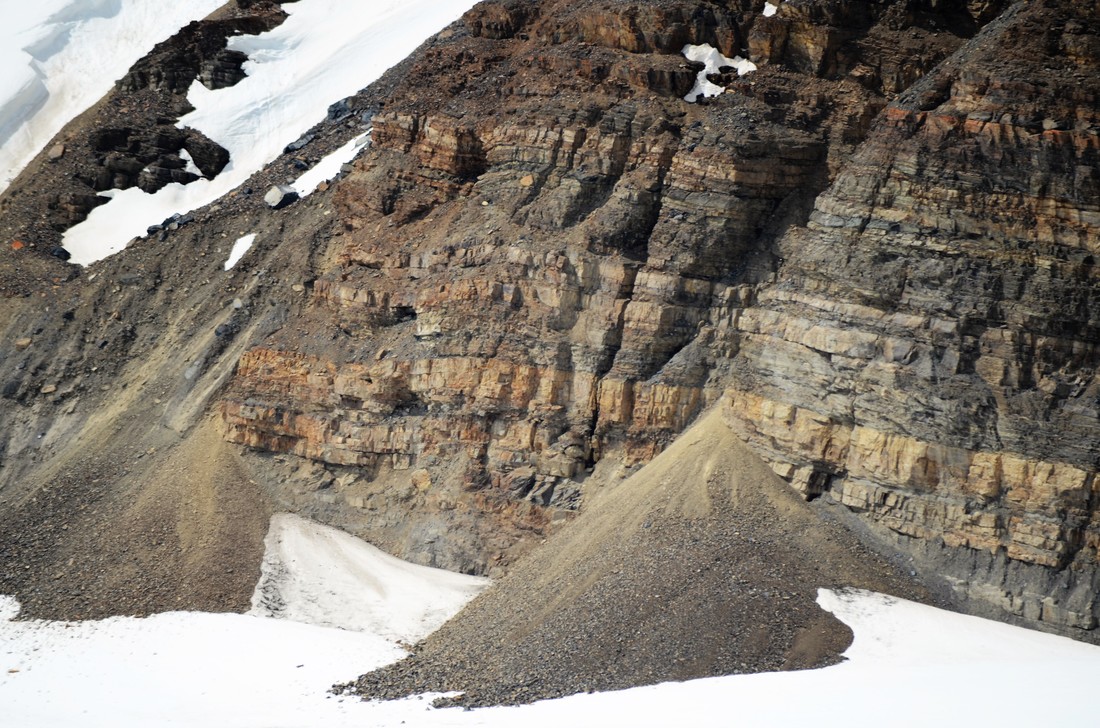The Past Sealed Away ...
Ice contains no future, just the past, sealed away. As if they're alive, everything in the world is sealed up inside, clear and distinct. Ice can preserve all kinds of things that way- cleanly, clearly. That's the essence of ice, the role it plays.
― Haruki Murakami, Blind Willow, Sleeping Woman
We are said to be firmly entrenched in a soon-to-be christened epoch, dubbed the “Anthropocene” by atmospheric chemist Paul Crutzen and diatom biologist Eugene Stoermer. This Period is defined as a new geologic age in which the activities of humans have significantly impacted our global climate, environment and ecology to such an extent as to permanently mark the lithosphere. It may be problematic to use the conventional parameters employed to determine division within the geologic time scale as indices of an anthropocentric period, as it is difficult to define human-generated geologic events that are truly global in nature, although the nuclear events of the 1940’s may, unfortunately, be described as such.
The “Anthropocene” is also commonly referred to as the “sixth extinction,” a period marked by rapid declines in biodiversity as more and more species become vulnerable to changes in their ecologies. There has been some debate regarding the actual start of this decline, as a range of dates seem to meet the formal requirements. Crutzen and Stoermer proposed the end of the 18th century, as they felt that the dawn of the Industrial Age - heralded by the invention of the steam engine and marked by notable changes in lake ecologies - signified changes that were due to human interventions. Evidence to support their proposed dating can been found in the form of atmospheric carbon dioxide levels in ice core samples.
There is no debate, however, regarding the culprits to be blamed for the changes that characterize this epoch: humans. One of the first researchers to describe human-induced environmental change was Alexander von Humboldt in 1800, after he had visited plantations at Venezuela’s Lake Valencia. Indeed, his writing includes many references to the effects that the human species has on the global environment. The promulgation of Humboldt’s observations has been used to pique the conscience of the public, and have also profoundly influenced some of the greatest thinkers, writers, and artists of our time: Johann Wolfgang von Goethe, Charles Darwin, Henry David Thoreau, and John Muir among them. In describing nature as an interconnected web in which humans play no small part, he enabled a more global view in which the earth’s resources were not seen to be inexhaustible. The deleterious and potentially irreversible impact of agriculture and mining were also brought to the attention of politicians and royalty of the time. Then, as now, most of those in positions of power chose the populist route, favouring economics and political expediency over long-term ecologic stewardship.
The role of art and artists in providing a record of our evolving landscapes and environment is incalculable. Artwork can provide a record and timeline of loss, and allow us to view and estimate rates of change. It can create nascent memories of what has vanished, and remind us of our role in that loss. It can translate alternate perspectives of our ecologies, and provoke public discourse and reflection.
As an artist who has often been preoccupied with translating environmental concerns into an artistic narrative, the opportunity to work with scientists in unpacking complex ideas and presenting them in another form has been critical to my practice.
The “Anthropocene” is also commonly referred to as the “sixth extinction,” a period marked by rapid declines in biodiversity as more and more species become vulnerable to changes in their ecologies. There has been some debate regarding the actual start of this decline, as a range of dates seem to meet the formal requirements. Crutzen and Stoermer proposed the end of the 18th century, as they felt that the dawn of the Industrial Age - heralded by the invention of the steam engine and marked by notable changes in lake ecologies - signified changes that were due to human interventions. Evidence to support their proposed dating can been found in the form of atmospheric carbon dioxide levels in ice core samples.
There is no debate, however, regarding the culprits to be blamed for the changes that characterize this epoch: humans. One of the first researchers to describe human-induced environmental change was Alexander von Humboldt in 1800, after he had visited plantations at Venezuela’s Lake Valencia. Indeed, his writing includes many references to the effects that the human species has on the global environment. The promulgation of Humboldt’s observations has been used to pique the conscience of the public, and have also profoundly influenced some of the greatest thinkers, writers, and artists of our time: Johann Wolfgang von Goethe, Charles Darwin, Henry David Thoreau, and John Muir among them. In describing nature as an interconnected web in which humans play no small part, he enabled a more global view in which the earth’s resources were not seen to be inexhaustible. The deleterious and potentially irreversible impact of agriculture and mining were also brought to the attention of politicians and royalty of the time. Then, as now, most of those in positions of power chose the populist route, favouring economics and political expediency over long-term ecologic stewardship.
The role of art and artists in providing a record of our evolving landscapes and environment is incalculable. Artwork can provide a record and timeline of loss, and allow us to view and estimate rates of change. It can create nascent memories of what has vanished, and remind us of our role in that loss. It can translate alternate perspectives of our ecologies, and provoke public discourse and reflection.
As an artist who has often been preoccupied with translating environmental concerns into an artistic narrative, the opportunity to work with scientists in unpacking complex ideas and presenting them in another form has been critical to my practice.
For this new series, The Past Sealed Away, I want to immerse myself in the properties of ice. One of my preoccupations is the rate of change in the environment: that profound environmental changes occur over time is not in question, but the increasingly accelerated rates point to an environment whose balance has shifted towards an inevitably catastrophic decline if not unchecked. The loss of ice, and the resultant impact upon environments are not trivial, and are of global concern. Central to my interrogation of these issues and the material nature of ice itself is one crucial question: How can my work provoke understanding and meaningful discussion around this loss?
I am cognizant also of collateral losses incurred through the loss of this ice, and intend to explore these problems as well. In losing this ice, we lose invaluable information about our environmental history – once this information is gone, it is lost to us forever. I feel it is vital to memorialize this loss in one of the works I am currently researching; to this end I will explore the cache of ice core samples and data for those samples which represent areas of ice which no longer exist. Where photographs of these samples are still extant, I will use this photographic documentation to replicate the lost ice core in white marble, tinting the marble to match the original sample. The identification number of the ice core sample, along with the name of the glacier from which it was taken, will be carved into the side of the replica. I am choosing white marble to recreate the ice cores for several reasons: white marble has historically symbolized both purity and immortality; there is a long history of its use in memorial architecture and art work, including for human grave markers; and it is porous and amenable to tinting. Once completed, the marble cores would be placed into an ice core storage rack for presentation/exhibition; this rack would be sourced from a disused storage freezer.
I intend the work I create to be exhibited in the centre of a darkened gallery space, along with a complimentary sound work. The sound work would be derived from recording the sounds made by ice in the landscape, which would be captured by a microphone lowered into bore holes after an ice core sample is removed. These recordings would be combined with throat singing; the resulting soundscape would offer a ”conversation” between the ice and the throat singer. As such, this sound work will allow those hearing it an opportunity to consider what philosopher Gaston Bachelard described in The Poetics of Space as the “intimate immensities” afforded to us by nature. The juxtaposition of the voice of the ice and the breath-inflected voice of the throat singer offer an aural link between what has been lost, what remains and the potential for human connection and recognition of the environment as a dynamic system, vital to our continued existence. To that end, I am also interested in how sound creates a sense of environment or space which can transport an audience to a different place. I was particularly taken by the descriptions of sound resulting from an icebreaker ship going through ice in the Antarctic – and confess that I would welcome any opportunity to experience that. 1
Additionally, I have been exploring graphic representations and notation of sound which can be presented to musicians and other creators to perform, and will explore the relationship between the physical structure of ice and sound, including instruments created from ice.
As I work conceptually, I often use a range of media throughout my research and development process. I use photography to record the things that I see that I wish to contemplate or research more fully, often using them as points of departure for discussion with others and as ways to elaborate concepts with my own ongoing work.
Painting and drawing are also an important part of that process; these works are not meant to be mimetic, but allow me to process information and impressions I gather over time. I feel that these methodologies will lend themselves to exploring the structure and physical properties of ice visually.
I am aware that the work I propose to do in this series would require a time frame that will extend beyond the proposed residency period, but the opportunity to do the research which will provide the foundation for the work is paramount to me.
The Peter Wall Institute affords the type of think-tank environment in which I work best, and the prospect of being able to realize the glacier project, along with exploring other areas of interest, is something I am truly excited about.
1- I am acutely aware of the resources that are required to accomplish fieldwork, and that each team member is required to perform more than one role. That being said, I would like to take the opportunity to point out that I have in the past worked as a lab technician in a microbiology lab, trained as a veterinary technician, worked a rehabilitation therapist with patients with degenerative neurological diseases, processed samples in the field for an ecology lab, and am not a bad cook…
I am cognizant also of collateral losses incurred through the loss of this ice, and intend to explore these problems as well. In losing this ice, we lose invaluable information about our environmental history – once this information is gone, it is lost to us forever. I feel it is vital to memorialize this loss in one of the works I am currently researching; to this end I will explore the cache of ice core samples and data for those samples which represent areas of ice which no longer exist. Where photographs of these samples are still extant, I will use this photographic documentation to replicate the lost ice core in white marble, tinting the marble to match the original sample. The identification number of the ice core sample, along with the name of the glacier from which it was taken, will be carved into the side of the replica. I am choosing white marble to recreate the ice cores for several reasons: white marble has historically symbolized both purity and immortality; there is a long history of its use in memorial architecture and art work, including for human grave markers; and it is porous and amenable to tinting. Once completed, the marble cores would be placed into an ice core storage rack for presentation/exhibition; this rack would be sourced from a disused storage freezer.
I intend the work I create to be exhibited in the centre of a darkened gallery space, along with a complimentary sound work. The sound work would be derived from recording the sounds made by ice in the landscape, which would be captured by a microphone lowered into bore holes after an ice core sample is removed. These recordings would be combined with throat singing; the resulting soundscape would offer a ”conversation” between the ice and the throat singer. As such, this sound work will allow those hearing it an opportunity to consider what philosopher Gaston Bachelard described in The Poetics of Space as the “intimate immensities” afforded to us by nature. The juxtaposition of the voice of the ice and the breath-inflected voice of the throat singer offer an aural link between what has been lost, what remains and the potential for human connection and recognition of the environment as a dynamic system, vital to our continued existence. To that end, I am also interested in how sound creates a sense of environment or space which can transport an audience to a different place. I was particularly taken by the descriptions of sound resulting from an icebreaker ship going through ice in the Antarctic – and confess that I would welcome any opportunity to experience that. 1
Additionally, I have been exploring graphic representations and notation of sound which can be presented to musicians and other creators to perform, and will explore the relationship between the physical structure of ice and sound, including instruments created from ice.
As I work conceptually, I often use a range of media throughout my research and development process. I use photography to record the things that I see that I wish to contemplate or research more fully, often using them as points of departure for discussion with others and as ways to elaborate concepts with my own ongoing work.
Painting and drawing are also an important part of that process; these works are not meant to be mimetic, but allow me to process information and impressions I gather over time. I feel that these methodologies will lend themselves to exploring the structure and physical properties of ice visually.
I am aware that the work I propose to do in this series would require a time frame that will extend beyond the proposed residency period, but the opportunity to do the research which will provide the foundation for the work is paramount to me.
The Peter Wall Institute affords the type of think-tank environment in which I work best, and the prospect of being able to realize the glacier project, along with exploring other areas of interest, is something I am truly excited about.
1- I am acutely aware of the resources that are required to accomplish fieldwork, and that each team member is required to perform more than one role. That being said, I would like to take the opportunity to point out that I have in the past worked as a lab technician in a microbiology lab, trained as a veterinary technician, worked a rehabilitation therapist with patients with degenerative neurological diseases, processed samples in the field for an ecology lab, and am not a bad cook…



